Canada employment grew 10.1k in November, slightly below expectation of 10.5k. Unemployment rate dropped from 5.2% to 5.1%, below expectation of 5.3%. Participation rate dropped -0.1% to 64.8%. Average hourly wages was up 5.6% yoy, staying above 5% level for the sixth consecutive month.
US non-farm payroll grew 263k, strong wage growth
US non-farm payroll employment grew 263k in November, above expectation of 200k. Average job growth was 282k over the prior three months, and 392k thus far in 2022. Unemployment rate was unchanged at 3.7%, matched expectations. Participation rate dropped -0.1% to 62.1%. Wage growth was strong with average hourly earnings up 0.6% mom, versus expectation of 0.3% mom.
Eurozone PPI at -2.9% mom, 30.8% yoy in Oct
Eurozone PPI came in at -2.9% mom, 30.8% yoy in October, versus expectation of -2.0% mom, 31.5% yoy. Industrial producer prices decreased by -6.9% in the energy sector, while prices increased by 0.2% for intermediate goods, by 0.3% for capital goods, by 0.5% for durable consumer goods and by 1.1% for non-durable consumer goods. Prices in total industry excluding energy increased by 0.5%.
EU PPI came in at -2.5% mom, 31.2% yoy. The largest monthly decreases in industrial producer prices were recorded in Ireland (-32.5%), Bulgaria (-8.8%) and Denmark (-5.5%), while the highest increases were observed in Greece (+9.6%), Hungary (+6.2%) and Belgium (+2.8%).
NFP watched as 10-year yield tumbled
US non-farm payroll report is a major focus for today. Markets are expecting 200k job growth in the US in November. Unemployment rate is expected to be unchanged at 3.7%. Average hourly earnings is expected to rise 0.3% mom.
The significance of today’s set of data might not be as high as earlier expected, after Fed Chair Jerome Powell’s speech two days ago. Powell clearly indicated that it “makes sense” to start slowing the pace of rate hikes, as soon as this month. That is, a 50bps hike is pretty much a done deal.
What matter now are the terminal rate of the tightening cycle, and the time to stay there. A month’s job data shouldn’t alter the expectations on these two issues much.
A key development to note is the surprised steep decline in 10-year yield overnight. The move away from 55 day EMA is clearly a bearish sign. But 3.483 might provide at least some interim support. Let’s see today’s NFP would trigger a recovery in TNX. If that happens, USD/JPY could also follow for a recovery.
BoJ Tamura called for review of monetary framework
BoJ board member Naoki Tamura told Asahi daily that a review of monetary framework should be conducted by the central bank. Such review could come “soon or at a somewhat later date”. “Whether the BOJ needs to tweak its monetary policy will depend on the outcome of the review,” he said.
Tamura also noted there was scope to review the feasibility of the 2% target, and consider it as a more flexible goal. “As long as the economy is achieving a virtuous cycle, I think it’s okay even if inflation is at, say 1.8%” instead of 2%,” he noted.
Fed Williams: Slowing rate hike is just stepping down one step
New York Fed President John Williams said yesterday in an interview that slowing the pace of rate hikes in December would simply mean “stepping down one step” in the effort to curb inflation.
“I still think we have a ways to go in terms of where the fed funds target is and where we need to get it to next year in order to get the sufficiently restrictive stance,” he said.
“Inflation, first of all, is the number one problem we’re facing in terms of monetary policy. It is far too high,” Williams said. And, bring inflation back to 2% target will “take a good couple of years”.
But he added: “I expect to see a pretty significant decline in inflation next year as supply chain issues improve, as we see the slowing economy, the economy getting into better balance.”
Fed Bowman: Appropriate to slow tightening pace, but terminal rate would be slightly higher
Fed Governor Michelle Bowman said she expect ongoing increase in rates at coming meeting. But, it will be “appropriate” to slow the pace of tightening. That will allow policymakers to full assess the impact of their actions.
Also, “we’re still seeing extremely high levels of core and CPI inflation,” she said. “Until I see our actions actually having some impact that would lower the rate of inflation, I think my expectation would be a slightly higher” terminal rate than projected back in September.
US ISM manufacturing dropped to 49 in Nov, first contraction in 29 months
US ISM Manufacturing PMI dropped from 50.2 to 49.0 in November, worse than expectation of 50.5 That’s also the first contraction reading in 29 months since May 2020. Looking at some details, new orders dropped form 49.2 to 47.2. Production dropped from 52.3. to 51.5 Employment dropped from 50.0 to 48.4. Prices dropped from 46.6. to 43.0.
ISM said: “The past relationship between the Manufacturing PMI and the overall economy indicates that the Manufacturing PMI for November (49 percent) corresponds to a 0.1-percent increase in real gross domestic product (GDP) on an annualized basis.”
US initial jobless claims dropped back to 225k
US initial jobless claims dropped -16k to 225k in the week ending November 26, below expectation of 245k. Four-week moving average of initial claims rose 2k to 229k.
Continuing claims rose 57k to 1608k in the week ending November 19. Four-week moving average of continuing claims rose 30k to 1539k.
US PCE slowed to 6.0% yoy in Oct, core PCE down to 5.0% yoy
US personal income rose 0.7% mom to USD 155.3B in October, above expectation of 0.4% mom. Personal spending rose 0.8% mom to USD 147.9B, matched expectations.
For the month, PCE price index rose 0.3% mom, below expectation of 0.5% mom. PCE core (excluding food and energy) rose 0.2% mom, below expectation of 0.4% mom.
From the same month ago, PCE price index slowed from 6.3% yoy to 6.0% yoy, below expectation of 6.0% yoy. PCE core price index slowed from 5.2% yoy to 5.0% yoy, matched expectations. Prices for goods rose 7.2% yoy and prices for services rose 5.4% yoy. Food prices rose 11.6% yoy and energy prices rose 18.4% yoy.
UK PMI manufacturing finalized at 46.5, further contraction, outlook darkened
UK PMI Manufacturing was finalized at 46.5 in November, up from October’s 46.2. S&P Global said intermediate goods remained the weakest performing sector. Business sentiment dipped to the lowest since April 2020. Input price inflation eased to three-month low.
Rob Dobson, Director at S&P Global Market Intelligence, said: “November saw a further contraction of the UK manufacturing sector, as weak demand, declining export sales, high energy prices and component shortages all hit industry hard. The outlook for the sector also darkened, as confidence among manufacturers fell to its lowest level since April 2020. … The trend in new export business was especially weak, as Brexit issues and supply chain stresses exacerbated the effects of a weakening global economic backdrop, leading to lower sales from the US, the EU and China.”
Eurozone PMI manufacturing finalized at 47.1, welcome moderation in downturn intensity
Eurozone PMI Manufacturing was finalized at 47.1in November, up from October’s 46.4. Looking at some member countries, Ireland PMI Manufacturing was at 48.7 (30 mth-low), Italy at 48.4, Greece at 48.4, France at 48., Austria at 46.6, Germany at 46.2, the Netherlands at 46.0 (29-mth low), and Spain at 45.7. All were in contraction.
Chris Williamson, Chief Business Economist at S&P Global Market Intelligence said: “The PMI signals some welcome moderation in the intensity of the eurozone manufacturing downturn in November, which will support hopes that the region many not be facing a winter downturn as severe as previously anticipated by many. However, the survey’s production index continuing to run at one of the lowest levels recorded over the past decade. At these levels the survey is indicative of a marked annualised rate of contraction of approximately 4%. While official manufacturing data have been more buoyant – and more volatile – in recent months, such weak PMI readings have always been followed by commensurate steep declines in the official statistics.”
Swiss CPI unchanged at 3.0% yoy in Nov
Swiss CPI was unchanged at 3.0% yoy in November, above expectation of 2.6% yoy. Core CPI (excluding fresh and seasonal products, energy and fuel) rose from 1.8% yoy to 1.9% yoy. Domestic product inflation rose from 1.7% yoy to 1.7% yoy. But Imported product inflation slowed from 6.9% yoy to 6.3% yoy.
FSO said: “The stability of the index compared with the previous month is the result of opposing trends that offset each other overall. Prices for housing rentals, gas and fuels increased, as did those for foreign and Swiss red wine. In contrast, prices for heating oil, fruiting vegetables and hotel accommodation decreased.”
Also released, retail sales dropped -2.5% yoy in October, worse than expectation of 3.3% yoy rise.
China Caixin PMI Manufacturing rose to 49.4 in Nov, pandemic continued to take a toll
China Caixin PMI Manufacturing rose from 49.2 to 49.4 in November, above expectation of 48.6. Caixin said that Covid-19 restrictions continued to constrain output. New orders fell, albeit at softest rate in four months. Supply chain delays worsened.
Wang Zhe, Senior Economist at Caixin Insight Group said: “Overall, the pandemic continued to take a toll on the economy. Output contracted, total demand was under pressure, overseas demand remained weak, employment deteriorated, logistics was sluggish, and manufacturers faced growing operating pressure. As the measure for suppliers’ delivery times is negatively correlated to the PMI, the fall in the measure partially offset the drop in the PMI, leading the decline in November manufacturing activity to be underestimated.”
BoJ Noguchi: Must maintain monetary easing
BoJ board member Asahi Noguchi said the central bank must continue to maintain monetary easing, keep interest rates at low levels now as achievement of 2% inflation target remains uncertain.
“While not as much as other countries, Japan’s consumer prices have risen sharply. This increase is driven mostly by rising imported goods prices,” he said. “What’s more important in deciding monetary policy is trend inflation based on domestic macro-economic factors, which remains at low levels.”
Inflation is likely to fall back below 2% once these cost-push factors dissipate.
Fed Powell: Makes Sense to start slowing, as soon as in Dec
Fed Chair Jerome Powell indicated in a speech that it “makes sense” to start slowing the pace of tightening as soon as in December. But, the level of the terminal rate, and the time to stay there are now more significant than when to start slowing down.
“Monetary policy affects the economy and inflation with uncertain lags, and the full effects of our rapid tightening so far are yet to be felt,” Powell said. “Thus, it makes sense to moderate the pace of our rate increases as we approach the level of restraint that will be sufficient to bring inflation down. The time for moderating the pace of rate increases may come as soon as the December meeting,” he added.
But Powell also indicated, “the timing of that moderation is far less significant than the questions of how much further we will need to raise rates to control inflation, and the length of time it will be necessary to hold policy at a restrictive level. It is likely that restoring price stability will require holding policy at a restrictive level for some time. History cautions strongly against prematurely loosening policy. We will stay the course until the job is done.”
US ADP employment grew 127k, Fed tightening having impact
US ADP private employment grew 127k in November, below expectation of 195k. By sector, goods- producing jobs dropped -86k. Service-providing jobs rose 213k. By establishment size, small companies lost -51k jobs. Medium companies added 246k. Large companies lost -68k.
Turning points can be hard to capture in the labor market, but our data suggest that Federal Reserve tightening is having an impact on job creation and pay gains. In addition, companies are no longer in hyper-replacement mode. Fewer people are quitting and the post-pandemic recovery is stabilizing.
BoE Pill expects headline inflation to tail off in 2nd half of next year quite rapidly
BoE Chief Economist Huw Pill said at a conference, “we are expecting to see headline inflation tail off in the second half of next year, in fact quite rapidly, on account of those base effects.” But, “there’s a lot of uncertainty around the outlook for gas price developments,” he added.
“Very low levels of unemployment and the association with the mid-1970s is not entirely reassuring from an inflection point of view,” Pill said. “People in the 50 to 65 age group, relative to pre-COVID levels, are having a higher level of inactivity not being in a job and not looking for work.”
Eurozone CPI slowed to 10% yoy in Nov
Eurozone CPI slowed from 10.6% yoy to 10.0% yoy in November, below expectation of 10.4% yoy. CPI ex-energy rose from 6.9% yoy to 7.0% yoy. CPI ex-energy, food, alcohol and tobacco was unchanged at 5.0% yoy.
Looking at the main components, energy is expected to have the highest annual rate in November (34.9%, compared with 41.5% in October), followed by food, alcohol & tobacco (13.6%, compared with 13.1% in October), non-energy industrial goods (6.1%, stable compared with October) and services (4.2%, compared with 4.3% in October).




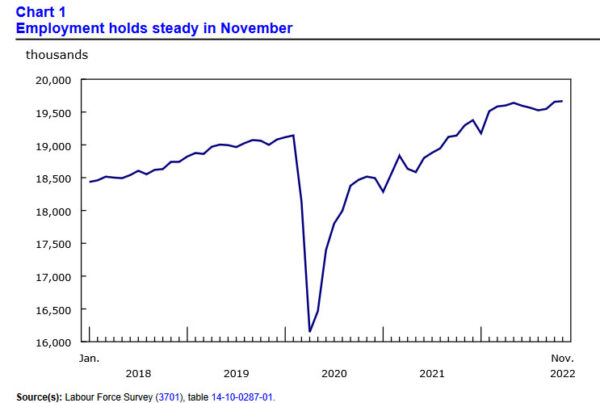
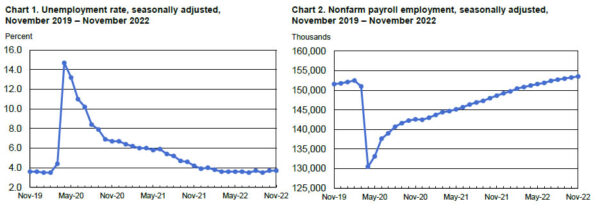
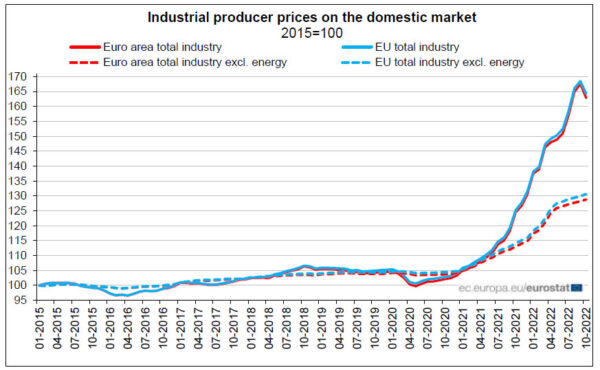
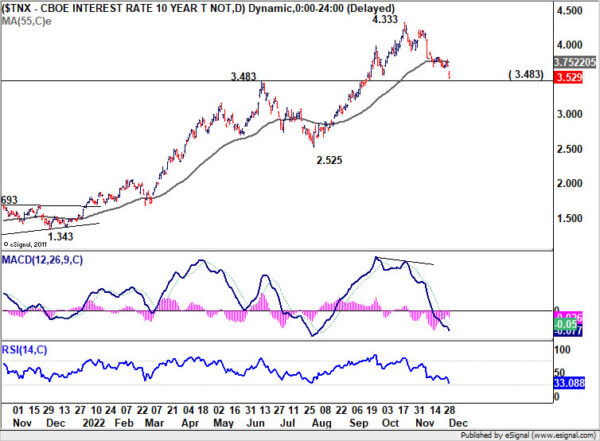
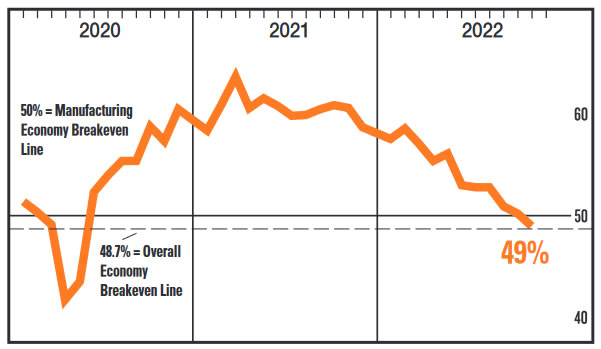
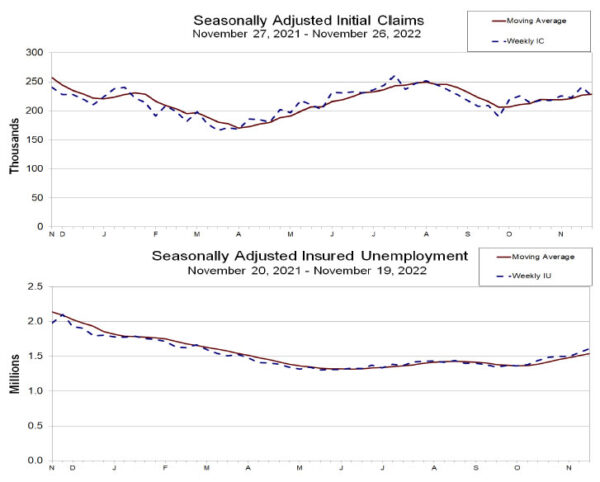
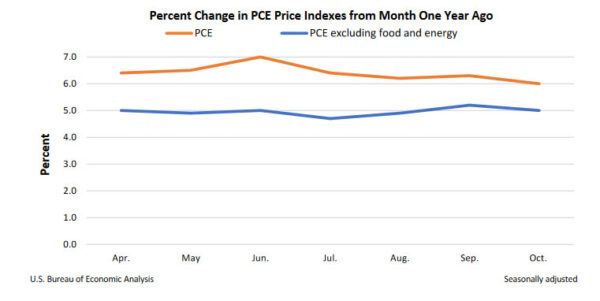
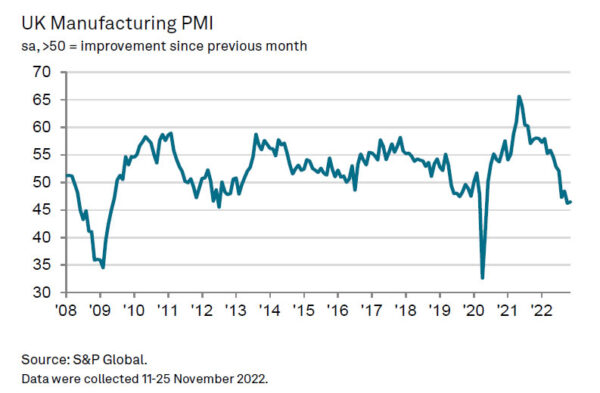
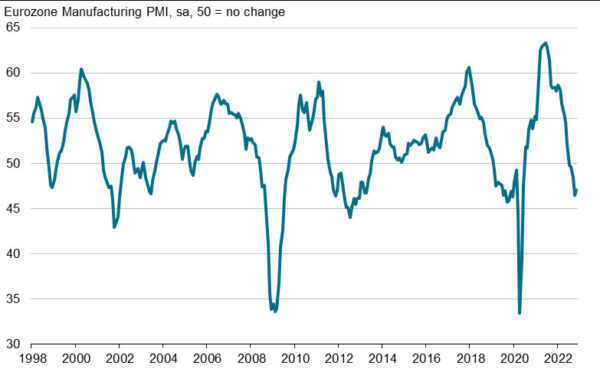
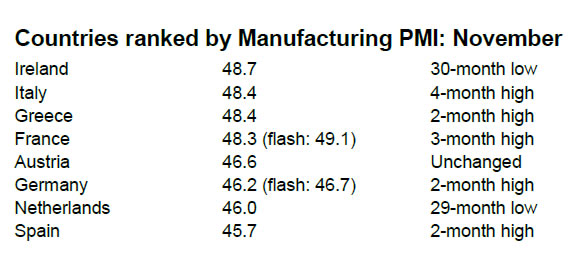
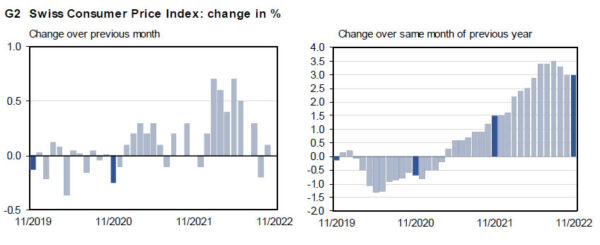
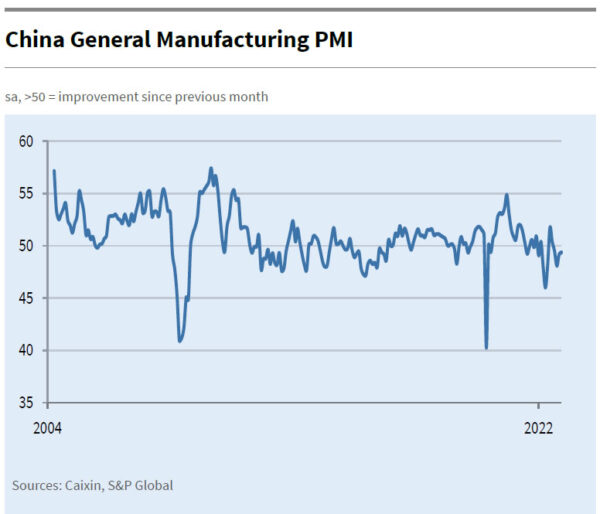



BoE Dhingra: Interest rate should peak below 4.5%
BoE MPC member Swati Dhingra said in an Observer interview that interest rate in the UK should peak below 4.5% to avoid deepening and prolonging a recession.
“You do see a much deeper and a longer recession with rates being much higher. That is what I think we should all be worried about … are we going to end up lengthening and deepening the recession if the tightening continues at the pace it is?” she said.
She added that those expecting more large rate hikes are not considering the fall in investment and employment as projected for the new two years. “These are not trivial numbers. The market has clearly not realized how pessimistic that could be for the UK economy,” she said. “The economic slowdown is here.”